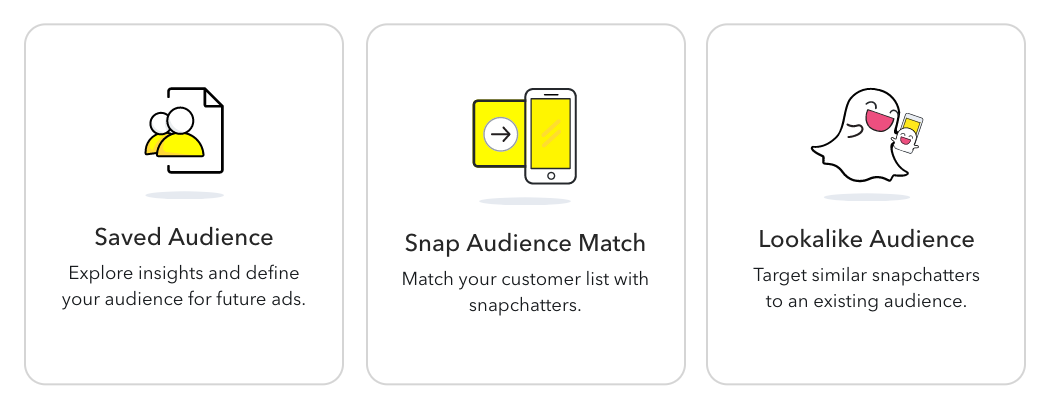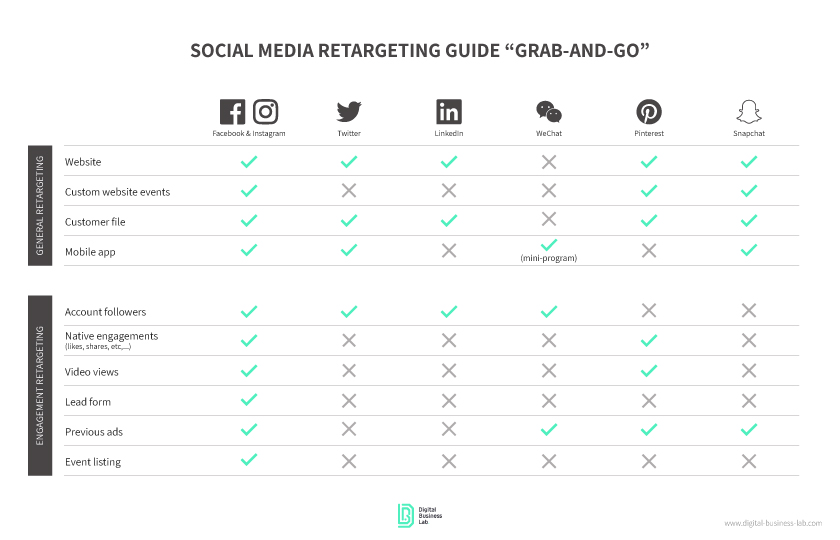To make it short: social media retargeting is all about blending original retargeting with retargeting based on user engagements like video views, reactions or event participation. In most of the major social media, see here below, the original retargeting is actioned based on a pixel or a tag placed in a website’s code or Google Tag Manager. But in all of them, to some extent, the retargeting based on engagement is possible and very much recommended!
Why do we recommend social media retargeting?
- As previously said, the original retargeting, that consists of serving ads to people that previously visited your website, is something possible on social media. On platforms like Facebook or Instagram, we will appreciate the ease in leveraging all types of ad formats, from video to carousels, as well as the ease in segmenting the website visitors based on page categories.
- In the social media Internet, brands are consistently seeking for users engagements whether the intent being to reinforce customer fidelity, to get free eyeballs (buzz, viral-effect), or simply to maximize all touchpoints. This is why social media retargeting via engagement is THE technique to leverage in any advertising campaign. For instance, brands can make sure that all their followers are being exposed to the latest product launch. As well, marketers can work on the customer funnel starting from engaging with emotionally appealing content, moving down to insightful content, and then closing with a promotion campaign.
Watch below our 2-min video related to this article.
Here is the “grab-and-go” infographic to summarize all of this information, feel free to use it!
Social media retargeting capabilities of each platform, from Facebook to WeChat.
1. Facebook retargeting, Instagram retargeting
You can do it all! Facebook is the retargeting powerhouse of social media advertising with features ranging from regular website retargeting, to video views retargeting, and all the way to customer lifetime value (LTV) retargeting. These are called “custom” audiences.
Here is an exhaustive list of all retargeting types available on Facebook & Instagram:
- General retargeting based on all website visitors.
- Retargeting based on page URL or Facebook events completed on the website.
- Retargeting based on a customer file, for instance from an extract of your database (make sure you are compliant with GDPR).
- Retargeting based on interactions with your app.
- Video views retargeting.
- Lead form opening or completion retargeting.
- Canvas or collection ad opening retargeting.
- Facebook Page or Instagram business profile (only!) interactions retargeting: followers, engaged, etc.
- Retargeting based on interactions with your Facebook Events.
2. Twitter retargeting
With Twitter retargeting, you’ll be able to leverage “Tailored Audiences”. Although not being as powerful as Facebook, Twitter offers an interesting range of capabilities including the very cool “@ retargeting”. Read on the list here below:
- General retargeting based on all website visitors.
- Retargeting based on a page URL of your website.
- Retargeting based on a customer file, for instance from an extract of your database (make sure you are compliant with GDPR).
- Retargeting based on interactions with your app.
- Retargeting based on the username (@digitalbizlab) of your account followers.
One common use of Twitter retargeting is to push app downloaders but not users to re-open and engage with the app. This tactic has been available for a long time on the platform and was a major selling point of Twitter back in 2014.
3. LinkedIn retargeting
LinkedIn is THE social media for B2B but only shows a few options to leverage retargeting. The main weakness of LinkedIn lies in the capabilities of users engagement retargeting: you can only retarget your company followers. Full list here:
- General retargeting based on all website visitors.
- Retargeting based on a page URL of your website.
- Retargeting based on a customer file, for instance from an extract of your database (make sure you are compliant with GDPR).
- Company Page followers retargeting.
4. WeChat retargeting
As WeChat motto could be “1 app to rule them all”, the retargeting capabilities are for now limited to triggers within WeChat and not outside of it. In other words, one can not do website retargeting on Wechat. Here is a list of what is possible on WeChat, you’ll see that it is quite different compared to the above social media:
- Public account followers retargeting.
- Retargeting people that have been using a mini-program of your account.
- Retargeting of users engaged with your ads in the past year.
- “48 hours followers retargeting”: within 48 hours after a user has followed a brand account, the brand can send an automated message directly to the user.
5. Pinterest retargeting
Pinterest offers retargeting capabilities close to Facebook & Twitter with both retargeting based on website visitors and based on engagements, with a small limitation as far as account approval for retargeting based on interactions. Here are the full social media retargeting capabilities of Pinterest:
- General retargeting based on all website visitors.
- Retargeting based on page URL or Pinterest events completed on the website.
- Retargeting based on a customer file, for instance from an extract of your database (make sure you are compliant with GDPR).
- Retargeting based on interactions (need to be a Pinterest advertiser with a verified website) with Pins.
6. Snapchat retargeting
Social media retargeting on Snapchat is getting stronger: advertisers can now retarget users based on similar triggers to the other platform. See the full list here:
- General retargeting based on all website visitors.
- Retargeting based on page URL or Snapchat events completed on the website.
- Retargeting based on a customer file, for instance from an extract of your database (make sure you are compliant with GDPR).
- Retargeting based on interactions with Snap Ads.

Did we miss any social media retargeting? Feel free to share with us your thoughts or contact us for your social media strategy!



